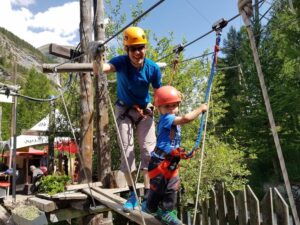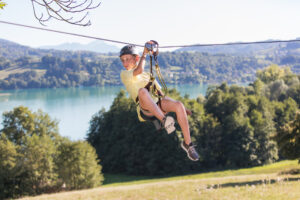Frequently Asked Questions
All what you need to know…
for specific question ask us directly

Why a safety line out of reach ?
This is a unique feature of Saferoller
An out-of-reach lifeline to enhance the experience of the participants, reducing the risk of injury as the lifeline is inaccessible
Children’s trails dedicated to small kids: 140 to 160 cm above the platform
Adult and family trails: 180 to 200 cm above the platform
How to manage verticalities with SAFEROLLER ?
To manage the verticalities we propose to install anti-return blockers.
Even if we prefer to use passive safety solutions, sometimes we have no choice.
Kanopeo proposes its novelty: the automatic anti-return device, which has the particularity to work in pure verticality but also for the softest ascents or descents
Are SAFEROLLER’s products
compatible with other safety belay systems?
NO ! never mix our products with other CBS
The certification of the system is a whole including the MCD and the continuous lifeline and its supports and components.
Risks of premature wear may appear or cause malfunctions.
Kanopeo cannot be held responsible for any consequences of inappropriate use.
Why is Saferoller particularly suitable for children? And from what age?

Saferoller was originally developed for children’s courses because it does not require any instruction (apart from putting the pulley on the cable at the beginning of the course), because it does not require any special handling, even for zip lines, and because the pulley cannot be taken off the cable by the participant.
Afterwards, it became clear to us that there was no reason to deprive adults of this revolutionary safety solution!
From what age? In fact it depends on the size of the harness provided by the operator, which limits the stature of the child downwards. In general, we recommend from 3-4 years old.
Of course, the trails should be adapted to the size of the children.
What are the advantages of the Speedrunner continuous lifeline system compared to other systems of the category D according to EN15567 ?
 The Speedrunner Continuous Belay System (CBS) was developed to provide a more economical alternative to Saferoller. But, of course, it joins its competitors in the higher operating costs inherent in a system that does not roll (instruction, handling during the passage of the supports, etc.).
The Speedrunner Continuous Belay System (CBS) was developed to provide a more economical alternative to Saferoller. But, of course, it joins its competitors in the higher operating costs inherent in a system that does not roll (instruction, handling during the passage of the supports, etc.).
The CBS based on the speedrunner grip permit a fast set up of the safety line and the Kanhook was the first to offer wear protection that is easily replaceable by the operator to extend lifespan, the possibility of safe evacuation with a tool, a swivel to protect your lanyards, compatibility with all pulleys on the market, TüV certification in compliance with the standards (EN17109 and EN795).
Explanation of each categories of CBS in norm EN15567 ?
individual safety system category A
self-closing device which is not automatically self-locking
individual safety system category B
self-locking device
individual safety system category C
interlocking device designed to reduce the likelihood of unintentional detaching from the safety system
individual safety system category D
interlocking device designed to prevent unintentional detaching from the safety system
individual safety system category E
device that is permanently attached during operation and can only be opened with a tool
Saferoller and Speedrunner are in the category E
What's MCD, ISS and safety line means?
MCD : Mobile Connecting Device
part of the ISS which is used to connect it to the safety line and allows the user to move along the safety line
ISS : Individual Safety System
component(s) connecting the harness to the safety line for protection against fall from height consisting of mobile connecting device(s), lanyard(s) and a connecting system to the harness which may be supplied as a pre-assembled product, or supplied by one or more manufacturer(s) and may be assembled by a user to make an ISS
safety line
flexible or rigid, horizontal, vertical or sloping, continuous or discontinuous device used as a protection against falling from a height.
Source : EN17109:2020
What kind of NORMS rules the ropes course industry ?
EN15567- 1/2 : construction and operation of ropes course
EN17109:2020 : Mobile Connecting Device for CBS
ACCT : copy paste from EU norms
How will I finally make money with a system that looks more expensive to buy ?
This is because the investment is a one-time investment that pays for itself, while your operating costs are your real costs.
If you need more staff to supervise your customers, to brief them and check their suitability for a long time, to do continuous maintenance during the operation period, etc. then you have made the wrong choice as an investor.
Saferoller allows you to minimize all these operating costs.
I am equipped with a traditional carabiner, can I easily switch to a continuous belay system?
Yes, both Saferoller and Speedrunner can be used to upgrade your installations to improve your safety and reduce your operation cost.
are all elements suitable for a continuous belay system as proposed by Kanopeo ?
To switch to Speedrunner, there are very few changes to make. For a Saferoller installation, certain adjustments and improvements are recommended in order to be able to take full advantage of the system and make your investment profitable.
But if you want to limit the changes, we have the ability to meet your needs thanks to the various specific supports developed since 2009.
Are ropes course an activity for the future?
Ropes Course is an activity in continual growing since the 90th. As a swimming pool it offer a sporty, mainly outdoor, activity for kids to old person.
What is the definition of an adventure park?
According French Public authorities an Adventure parks at height are spaces for secure playful activity allowing the practitioner to walk at height, independently and more or less acrobatically, on and/or between trees or other natural or non-natural supports.
Tree climbing is part of the acrobatic courses at height and consists of climbing trees using temporary equipment. A tree climbing activity must be carried out with a qualified instructor.
Source: DGCCRF
